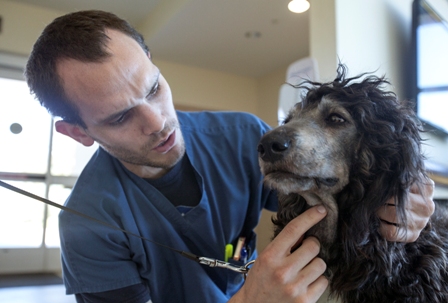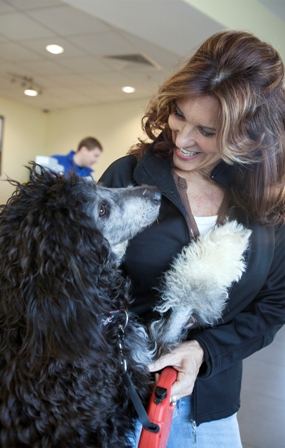UF treats first animal in new hyperbaric chamber

By Sarah Carey
A dog bitten by a rattlesnake is now home with her owners and doing well after becoming the first patient at the University of Florida Small Animal Hospital to receive treatment in a new hyperbaric oxygen chamber, one of only a small number in the country being used in veterinary medicine.
The 1-year-old Siberian husky/Standard poodle mixed breed dog, named Jackie, was given a clean bill of health during a recheck appointment on Oct. 30, 11 days after her initial arrival at UF.
Her owners, Joe and Jan Smith of Clermont, Fla., found their beloved pet lying on a bloody floor near a water bowl filled with bloody red fluid on Oct. 18. Jackie had played outside earlier with other family dogs inside the family’s small, fenced yard but seemed fine when she came indoors.
After finding her collapsed a short time later, the Smiths rushed Jackie to the Leesburg Veterinary Emergency Clinic, where veterinarians told them Jackie had been bitten by a rattlesnake.

“They told us she had less than a 40 percent chance at survival,” Jan Smith said. “We wanted to do everything we could for her. She deserved a chance and we told them to go ahead with the antivenom therapy.”
Veterinarians treated Jackie overnight with two vials of antivenom, then recommended that the Smiths take Jackie to UF for continued treatment the next morning.
“When Jackie arrived, she was in shock and experiencing dangerously low blood pressure and accelerated heart rate,” said Dr. Alessio Vigani, a resident in emergency and critical care medicine at UF. “We provided fluid therapy and administered two vials of antivenom immediately after she arrived.”
Three more vials were given over the next 24 hours as Jackie, who had been bitten multiple times near her muzzle, struggled to survive. Within 12 hours, the tissue around Jackie’s bite wounds started turning black and had a copious bloody discharge. At that point, UF veterinarians decided that she would be a candidate for hyperbaric oxygen therapy.
“We thought Jackie might benefit from the treatment, as snakebite wounds are associated with tissue death,” said Dr. Justin Shmalberg, a clinical assistant professor of integrative medicine at UF. “Such damage generally requires extensive surgery and additional hospitalization, which adds a large amount to the bill and to the animal’s time here.”
The treatment is provided inside of a tube-shaped container known as a hyperbaric chamber, through which animals receive highly pressurized, 100 percent oxygen delivered to tissue that wouldn’t receive it otherwise. Shmalberg and UF veterinary technician Wendy Davies recently received extensive training in the safety protocols associated with the use of the hyperbaric chamber, which was installed at UF in mid-October.

Over the next three days, Jackie received three treatments, each lasting about an hour. Although they were optimistic the treatments would help Jackie, UF veterinarians were nonetheless surprised by what they saw.
“After the first two treatments, there was an impressive improvement of the swelling, discharge and discoloration of the area,” Vigani said. “It was totally unexpected. The area that 24 hours before, we had no doubt would have required surgery, after the second treatment was almost completely healed.”
Although hyperbaric oxygen therapy is available and used worldwide in human medicine, with many scientific publications reporting beneficial effects for human diseases and in animal models, its use in veterinary medicine is relatively new, occurring primarily during the past decade.
Hyperbaric chamber technology is now being used by a small number of veterinary practices and an even smaller number of academic institutions to treat conditions that include non-healing wounds, particularly external wounds where there are concerns about blood supply. Crush and burn injuries and trauma injuries, such as might be caused by animals being hit by cars, being in dog fights or being bit by a snake.
Internal injuries with extensive tissue damage, such as pancreatitis, spinal cord and brain injury, are also likely to respond favorably to the treatment, veterinarians say.

Animals that receive hyperbaric oxygen therapy typically feel no discomfort, other than perhaps feeling some anxiety at being in a confined space, Shmalberg said.
“To a dog, it’s like diving down into water, with increased pressure around the body,” he said. “Anyone who has free-dived deeply knows that you need to be able to clear your ears. After that, most animals tend to fall asleep.”
He said veterinarians are still learning how often to treat animals, but that in general hyperbaric oxygen treatment tends to be performed once or twice a day, with about four hours between treatments to allow time for the animal to recover from the increased pressure in the environment.
“We are always looking for new and emerging ways to treat different conditions, such as non-healing wounds,” Shmalberg said. “While we are excited to have this new tool available, we also feel a responsibility to advance our scientific knowledge of how the technique is best used in animals.”
Such information will help veterinary practices refine the circumstances in which hyperbaric oxygen therapy will help to alleviate a patient’s symptoms, he added.
As for Jackie, her owners are ecstatic that the dog they call “a treasure to our family” is still with them.
“We are completely overwhelmed with joy that Dr. Vigani and the staff at the UF Small Animal Hospital were able to save Jackie’s life,” Jan Smith said. “Not only did they save her life, but they saved her from having surgery on her skin from the immense swelling. As I am typing this, Jackie has her paws on my chair and is licking my face and I’m smiling through my tears.”

